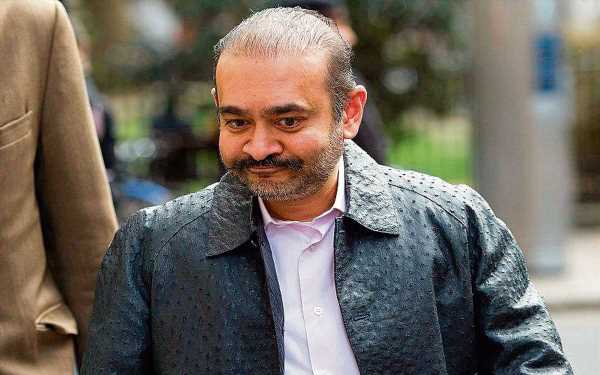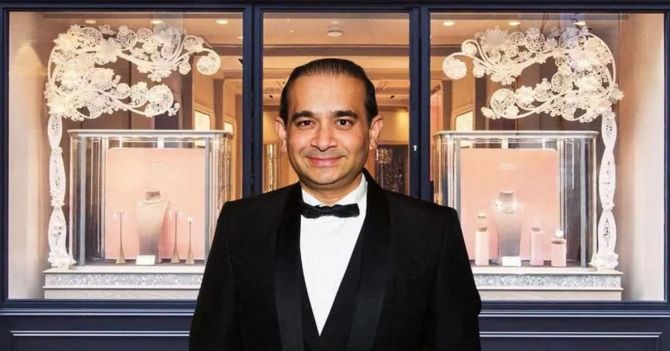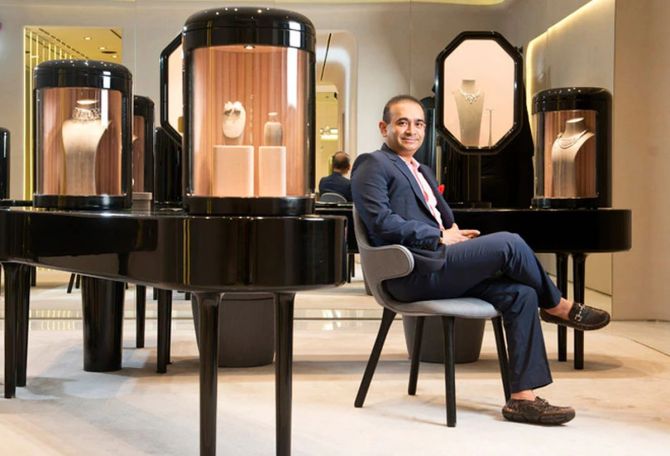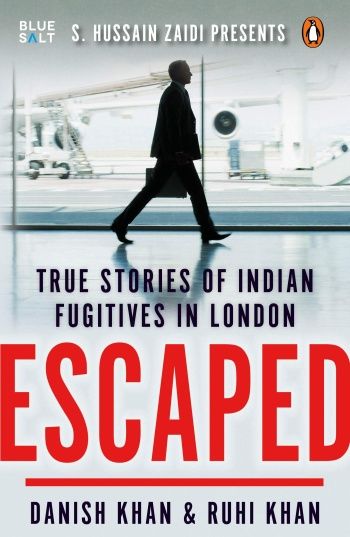The British home secretary has granted permission for jeweller Nirav Modi’s extradition to India.
During their arguments in a London court, his lawyers claimed Modi suffers from mental illness and is a suicide risk if he was sent to Mumbai’s Arthur Road jail.
A fascinating excerpt from Danish Khan and Ruhi Khan’s Escaped: True Stories Of Indian Fugitives In London.
The stage was now set for the CPS (Crown Prosecution Service) to make out a prima facie case on the charges of criminal conspiracy for causing the disappearance of evidence and criminal intimidation to cause death, and for the defence to counter that.
These charges were broadly spelt out with four instances — the transfer of documents relating to the LoU applications to Cyril Amarchand Mangaldas, a law firm; moving the Dubai-based dummy directors to Cairo against their will; threatening to kill Ashish Lad and destroying a server in Dubai which had data relating to Nirav Modi’s companies.
Helen Malcolm then took the proceedings further by fleshing out the charges of destroying evidence. She began with the large-scale transfer of documents to Modi’s solicitor in Mumbai to ensure that they were not available to investigators…
Before lunch, the court was shown a video of around twenty minutes featuring five employees of Modi. They could be heard saying that they were forced to sign documents and were kept in Cairo where they were totally under the control and at the mercy of Modi.
Wearing t-shirts and speaking in both English and Hindi, a couple of them gave graphic accounts of how Nirav and his brother Nehal Modi kept them in Cairo after twice replacing their mobile phones. One of them, Ashish Lad, it was alleged, was directly threatened to be killed by Modi, and was also offered Rs 20 lakh to travel to Europe and make a statement before a lawyer…
Modi appeared in the court through video link and heard the proceedings surrounded by papers, and kept shuffling to keep pace with the materials referred from different files. He wore a black suit with a white shirt, and sported a beard and moustache.
The second video, shown after lunch, was of barrack 12 of the Arthur Road Jail, accompanied by a running commentary. The court was informed that currently there was no inmate in barrack 12 — the last occupants were media baron Peter Mukerjea and Nationalist Congress Party leader Chhagan Bhujbal…
The video began with the claim that it had been made without artificial light sources and had a running commentary spelling out the dimensions of the cell and the facilities — twenty feet high, three windows, three ceiling fans, LED television and an attached toilet. The cell was described as having sufficient sources of natural light, and fresh air with cross ventilation…
After listening patiently to Malcolm, Montgomery told the court of the ‘evidential black holes’ in the case put up by India.
It was wrong, she continued, to say that after the credit facilities were withdrawn, Modi did not try to set things right with Punjab National Bank.
She spoke about the IPO plans and the correspondence between Modi and the bank as proof enough to restart the credit facilities. This was stated to counter the CPS which maintained that documents were transferred to the offices of the law firm when PNB declined to issue LoUs and the CBI had started investigations.
There was nothing to show that ‘documents (transferred to the law firm) were to be destroyed to pervert the course of justice’.
The documents were sent to the law firm for advice and not for destruction. The evidence given by India needed to be looked at with a ‘certain degree of rigour’, Montgomery said…
On the charge of employees being taken to Cairo, Montgomery said they were party to circular trading and that no offence could be said to have been committed against them…
The highlight on Day 2 though was the coming out in the open in full force of the extent of Modi’s mental illness. The court heard that Modi… was accessing the counselling facility in Wandsworth prison.
‘It’s not his wish that he should become as ill as he has become,’ said Montgomery. The defence was pursuing a legal battle to get private counselling for Modi, as the outbreak of COVID-19 had disrupted prison provisions. Modi’s mental illness meant that the defence could link it with the provisions in Arthur Road Jail.
There was no assurance that Modi would be protected against further deterioration to his mental health. A high risk of suicide, she said, makes it imperative for the court to enquire whether there are proper facilities and appropriate arrangements in the requested state…
Terming the assurance given by the GoI as ‘laconic’, Montgomery said that Modi’s psychiatric condition and the COVID-19 pandemic rendered the assurance ‘utterly inadequate’…
Written witness statements were provided by two journalists whose full names were not disclosed in the court, but were subsequently learnt — they were Rajat Guha and Pushp Sharma.
Their statements revolved around the working of the CBI and ED and the conduct of the ‘biased media’ in India.
‘Due to immense public pressure, investigations and judicial process will be influenced if Nirav Modi goes back,’ said Montgomery quoting from the statements. Just like in the Mallya case, where Rakesh Asthana came under special mention, the witness statements, which were read in the court spoke about certain favourite officers who get orders from the home minister and prime minister, and control the narrative that suits the government, the court heard…
Dr Richard Coker — professor emeritus of public health, London School of Hygiene and Tropical Medicine — was the first witness of day four, appearing though a video link from Bangkok…
‘My prediction is that there is a 5 per cent chance of Nirav Modi getting COVID and if he gets it then 15 per cent chance of dying,’ said Dr Coker. Montgomery then asked him to elaborate on the management of COVID-19 at Arthur Road Jail, testing strategy, and the rate of infection in Mumbai with the percentage-wise COVID-19 prevalence in the slum population and the rest of the city…
Dr Coker told the court that from the information furnished by India, he couldn’t form any final conclusions, and there was a need to be cautious as it was not clear how the tests were applied, the quality of the laboratory and other such issues. Dr Coker then spoke about how he did not agree with India’s characterization that their data defeats his opinions and that he made sweeping generalizations.
‘The route for transmission of COVID is aerosols that hang for fifteen to sixteen hours,’ he said in an apparent reference to enclosed cells being comparatively safer than one with more inmates.
The issue of enclosed cells, mental well-being and psychiatric support figured in the evidence of Dr Andrew Forrester who was next after Dr Coker’s evidence…
‘I first saw him in September 2019 and his condition has deteriorated and is severe. Deception is unlikely because he has a history of depression. He has developed more severe signs of depression,’ remarked Dr Forrester in his opening statement.
The court heard that Modi had been taking anti-depressants and the lockdown at Wandsworth prison had resulted in less time socializing, and greater time inside the cell had made the symptoms more severe.
‘Depression can come and go; however, in Modi’s case, numerous factors are around to perpetuate — like this hearing — and being in prison, he has not been receiving treatment that he needs,’ said Dr Forrester. He further described Modi as someone who presents a ‘high risk of suicide’ and who could become ‘unfit to plead in future’…
The third and last witness was Dr Alan Mitchell who like Dr Forrester was in court to give live evidence… The video of barrack 12 was played again after Dr Mitchell said that he would only be able to answer after watching the video…
Dr Mitchell dwelt on the adverse effect on Modi’s mental health due to possible solitary confinement in barrack 12, even for a short period. He pointed out that there was no psychiatrist or psychologist in Arthur Road Jail. Malcolm’s parting shot to Dr Mitchell was that ‘nothing the government of India does will satisfy you’. ‘What is important and appropriate is a psychiatrist cover,’ said Dr Mitchell…
In January 2021, the closing arguments of the trial saw Malcolm raise two extradition cases to argue against Modi being sent to India. The first case mentioned was of paedophile Raymond Varley… who was discharged when a witness statement on his mental health went unchallenged by India.
In Modi’s case too, India left it unchallenged until the last day and hence the court declined their request to have their expert examine Modi, agreeing with Montgomery that it should have been made earlier.
The other case cited was of bookie Sanjeev Chawla. The high court in the UK was convinced by assurances given by India that the prison conditions in Tihar Jail would meet with the ECHR guidelines and the CPS barrister requested that court that India should be given an opportunity to put forth any assurances that the court required to be satisfied with the jail conditions for Modi.
But what Modi would be pinning all his hopes on is the judgment by district judge Vaneesa Baraister in the extradition case of WikiLeaks’s founder Julian Assange to the US. Baraister began by the arguments put forward by the US for Assange’s extradition, only to conclude that the extradition would be oppressive as there was a likelihood of Assange dying by suicide in a US prison…
The repeated refusal of bail for Modi has added an interesting dimension to the extradition case. The many judges that have heard his bail plea have inferred that as a single man of relatively expansive means, Nirav Modi cannot be trusted to remain in the United Kingdom. They also concur that his escape could put the welfare of the many others who spoke against him at great risk.
This edited excerpt from Escaped: True Stories Of Indian Fugitives In London by Danish Khan and Ruhi Khan has been used with the kind permission of the publishers, Penguin Random House India.
Source: Read Full Article




